
Pressmeddelande -
Genetic findings may preserve threatened buffalo species
Researchers at the Swedish University of Agricultural Sciences (SLU) and Uppsala University have in an international collaboration with Bogor Agricultural University (IPB) and the Indonesian Institute of Sciences (LIPI) in Indonesia identified two independent mutations in the MITF gene underlying white-spotted coat colour in the swamp buffalo. The results can be used to preserve the threatened white-spotted buffalo, which is a culturally and economically important domestic animal.
White coat colour in animals has always fascinated humans as it is often surrounded by mystery and consequently the white coat colour has been strongly selected for in our domestic animals. This also holds true for the Asian water and swamp buffalo (Bubalus bubalis carabanensis).
The water buffalo is an economically very important domestic animal in large parts of Southeast Asia and in particular the white-spotted buffaloes are also culturally important. In the Toraja region located in the southern part of Sulawesi, Indonesia, a particularly important population of white-spotted buffaloes exist that are considered holy and that the Toraja people has selected for according to ancient funeral traditions. The holy white-spotted buffalo bulls are sacrificed in funeral ceremonies when an individual has passed away as this is considered as being necessary for a “safe ride to heaven”.
After the funeral ceremony, the meat is taken care of and is an important food resource for the Toraja population. The cultural tradition of sacrificing white-spotted buffaloes is also a major attraction for tourism and therefore economically important in the Toraja region. Because the genetic factors responsible for the white-spotted coat colour have been unknown and the fact that if the mutations that the researchers now have identified are inherited from both parents the resulting embryos die during development. These circumstances have made it difficult to effectively breed sufficient number of white-spotted buffaloes. The population of white-spotted buffaloes has therefore undergone a drastic decrease in number during the recent past years and today these charismatic animals are threatened to become extinct.
“We have in a successful collaboration with researchers in Indonesia investigated the genetics underlying the white-spotted coat colour in Indonesian swamp buffaloes by performing a comparison between white-spotted and normally coloured brown buffaloes”, says Maria Wilbe, researcher at Uppsala University and one of the authors of the study.
“The white-spotted coat colour suggested a defective development and migration of melanocytes, the cells that are responsible for melanin pigment production and we therefore decided to examine the MITF gene which we know is crucially important for the development and migration of melanocytes”, says Göran Andersson, professor at the Swedish University of Agricultural Sciences (SLU) who has led the study.
“We identified two independent mutations in the MITF gene each resulting in lack of production of functional MITF proteins. The mutations that we identified have a dominant effect on the coat colour phenotype and the white-spotted buffaloes become white when they inherit the mutation from one of the parents. The identification of two independent mutations in the same gene is evidence for how tremendously strong the selection for this white-spotted coat colour trait has been”, says Göran Andersson.
The results of this study have enabled Yulnawati Yusnizar, researcher at LIPI and one of the authors of the study, to open a breeding center for white-spotted buffaloes. The center, which is located in the city of Bogor, Java, Indonesia is called The Indonesian Buffalo Conservation & Breeding Center. Based on our results we have developed a methodology allowing the identification of in vitro fertilized embryos that will develop into white-spotted buffaloes following embryo transfer. This technology will increase the possibilities to preserve the white-spotted buffaloes, says Maria Wilbe.
Contact:
Maria Wilbe, maria.wilbe@igp.uu.se, +46 (0)73 655 1989
Göran Andersson, goran.andersson@slu.se, +46 (0)70 380 8919
Article: http://onlinelibrary.wiley.com/doi/10.1111/age.12334/epdf
Ämnen
Kategorier
Regioner
SLU:s vision: SLU är ett universitet i världsklass inom livs- och miljövetenskaper.



